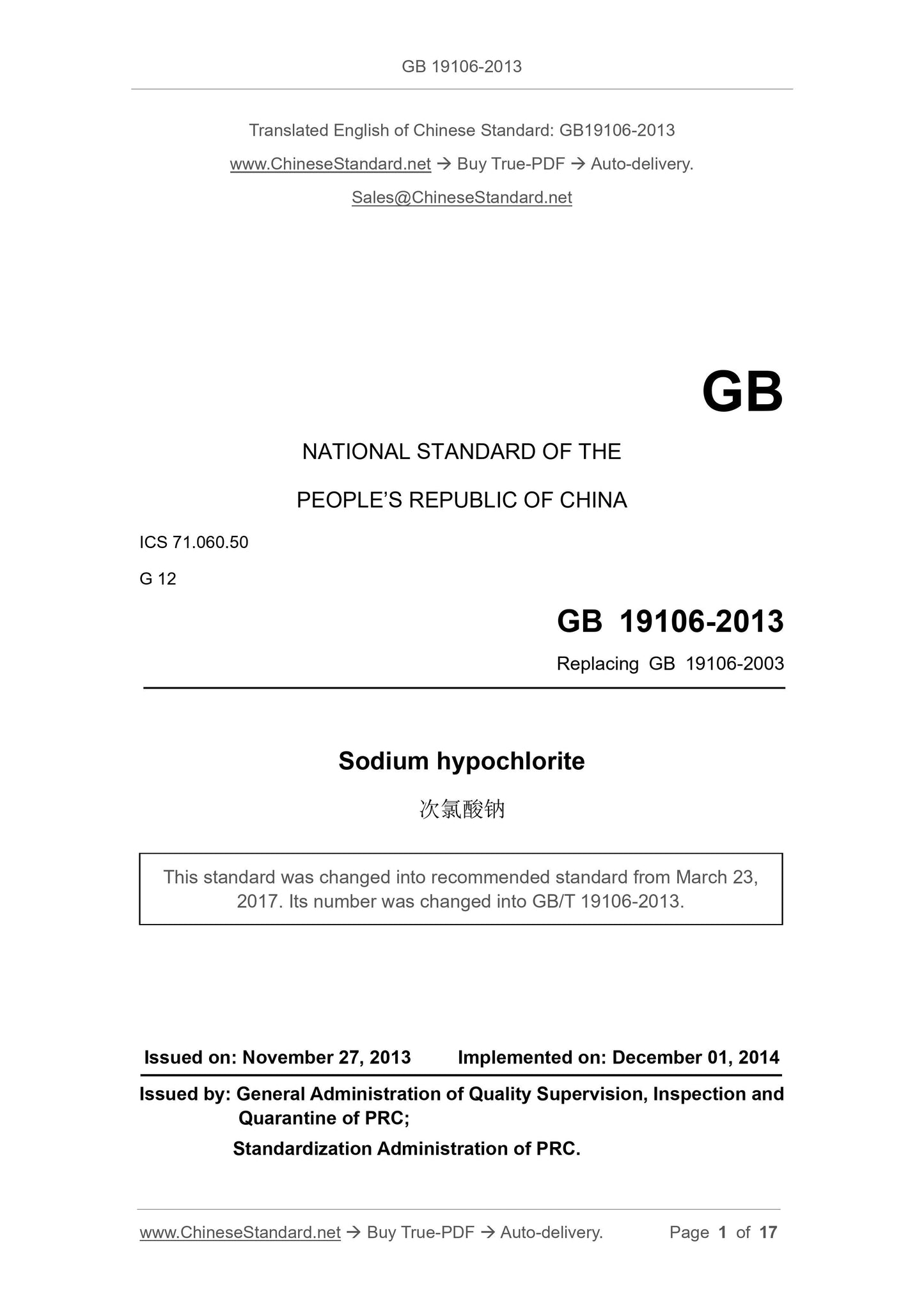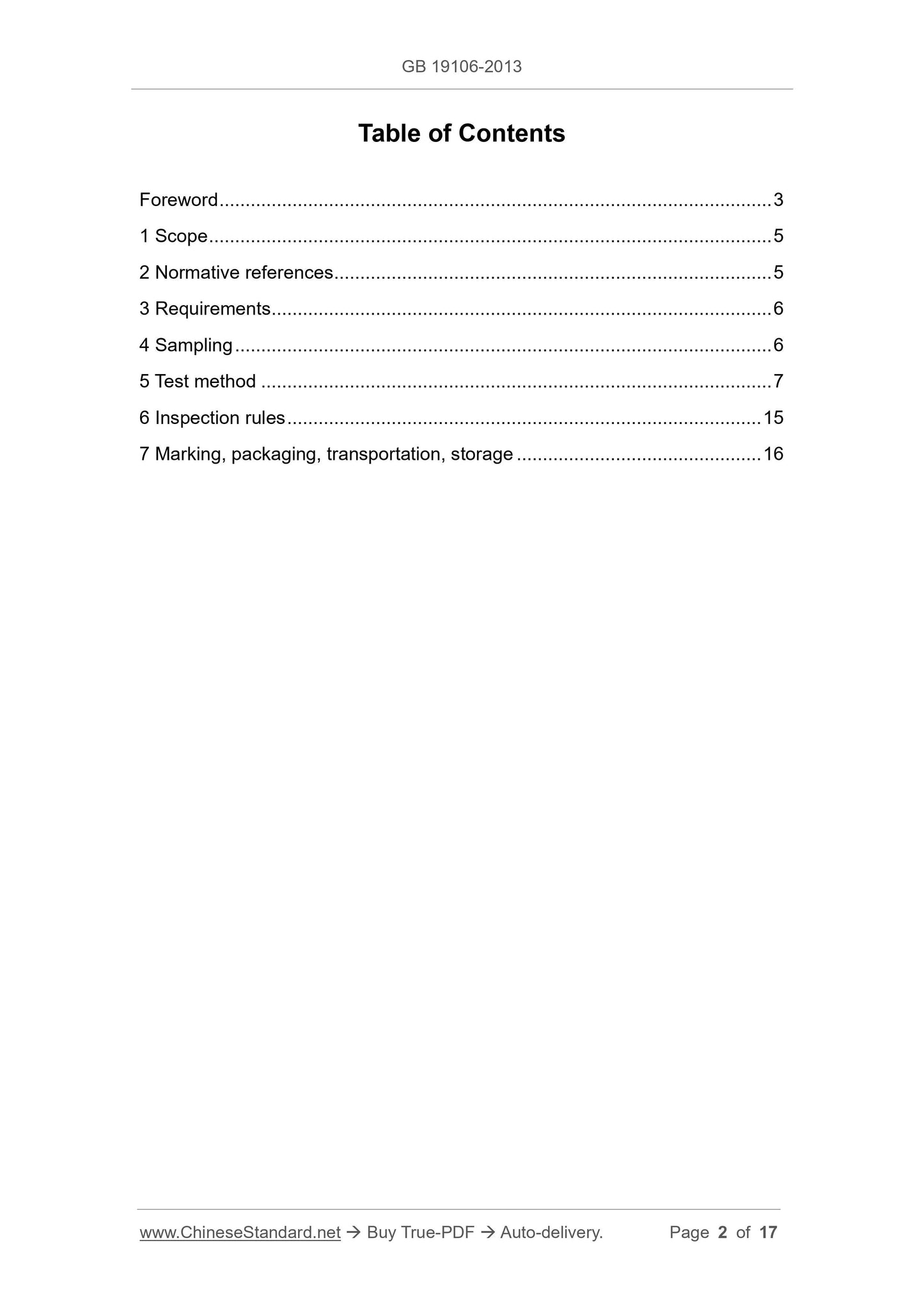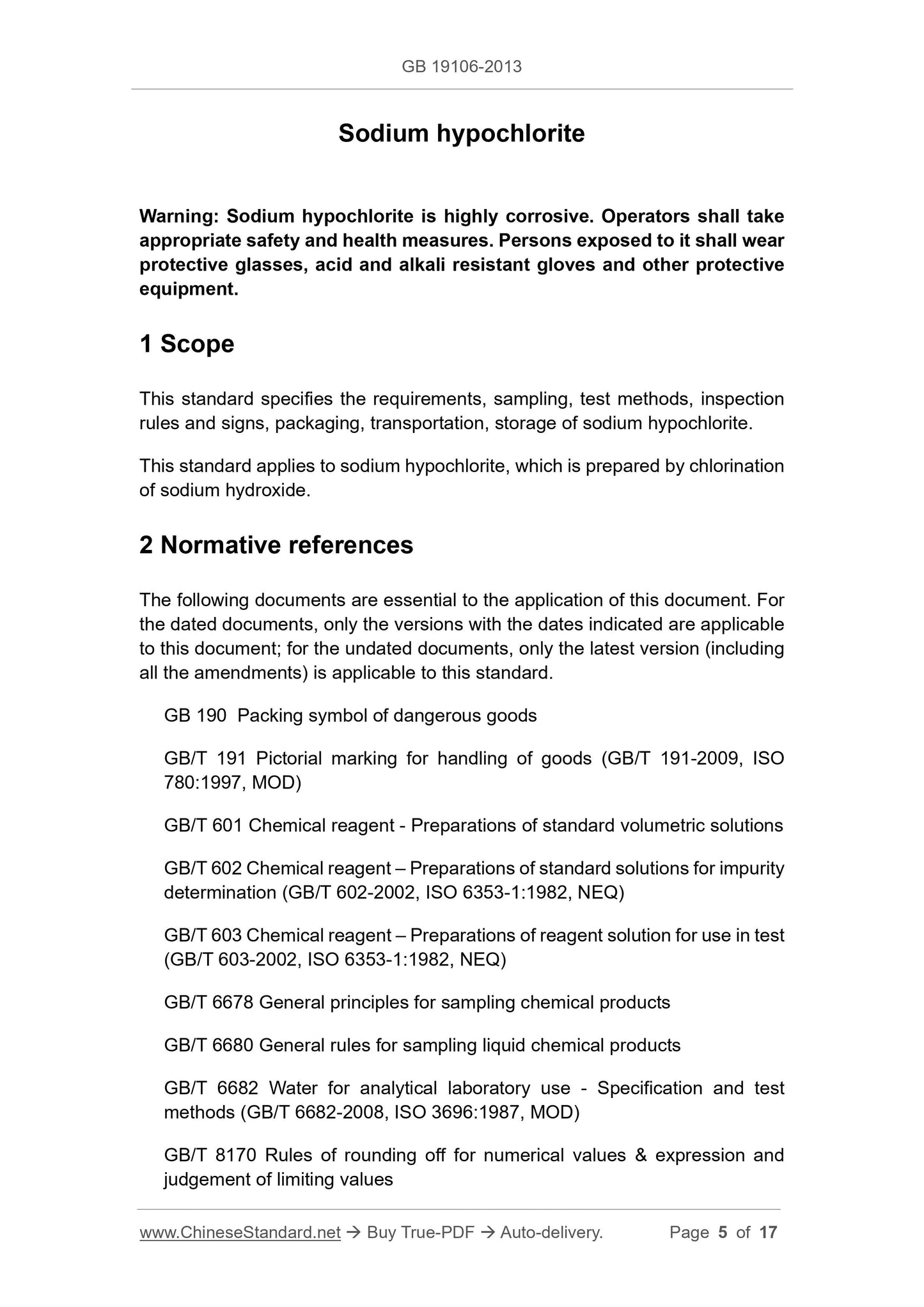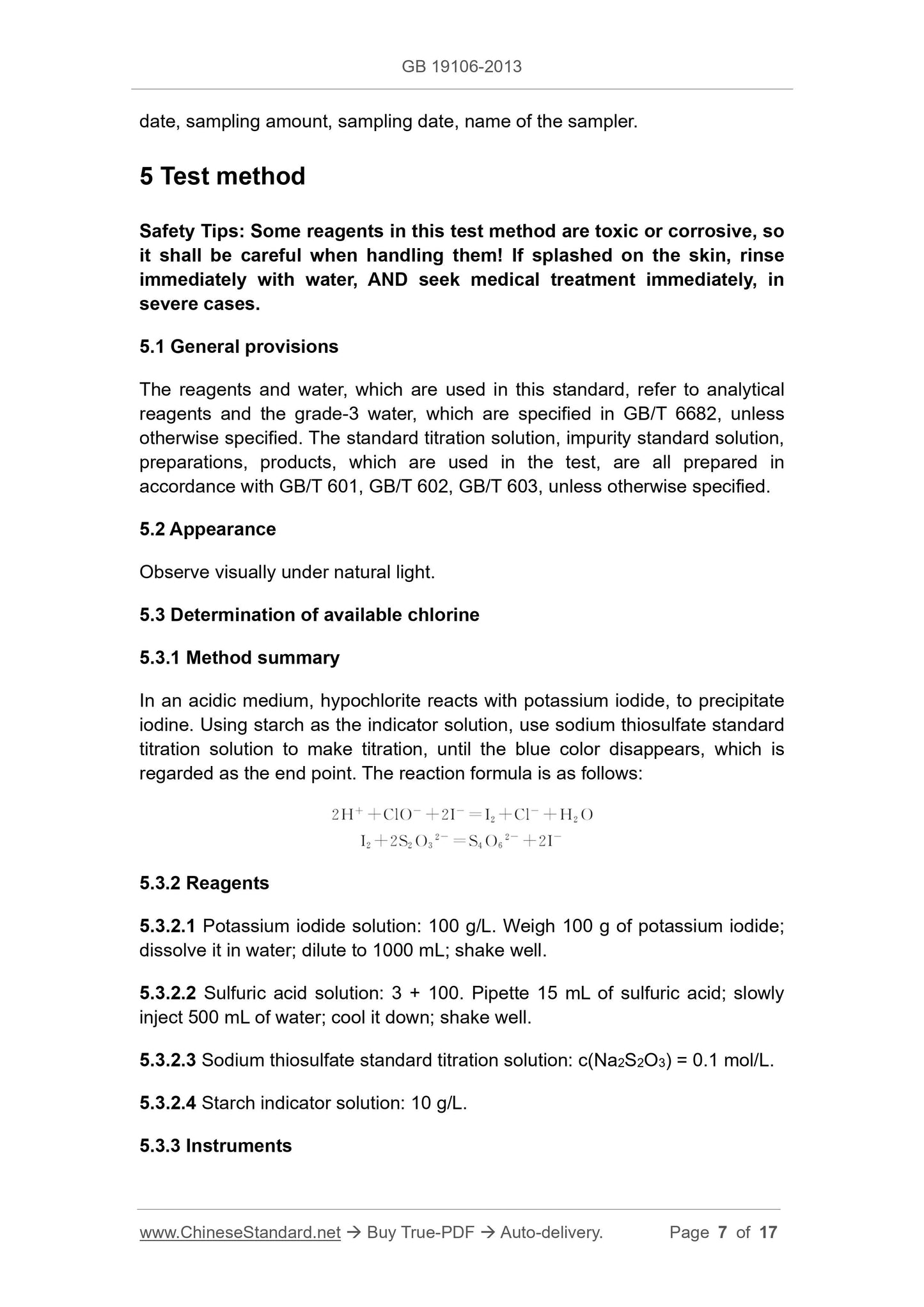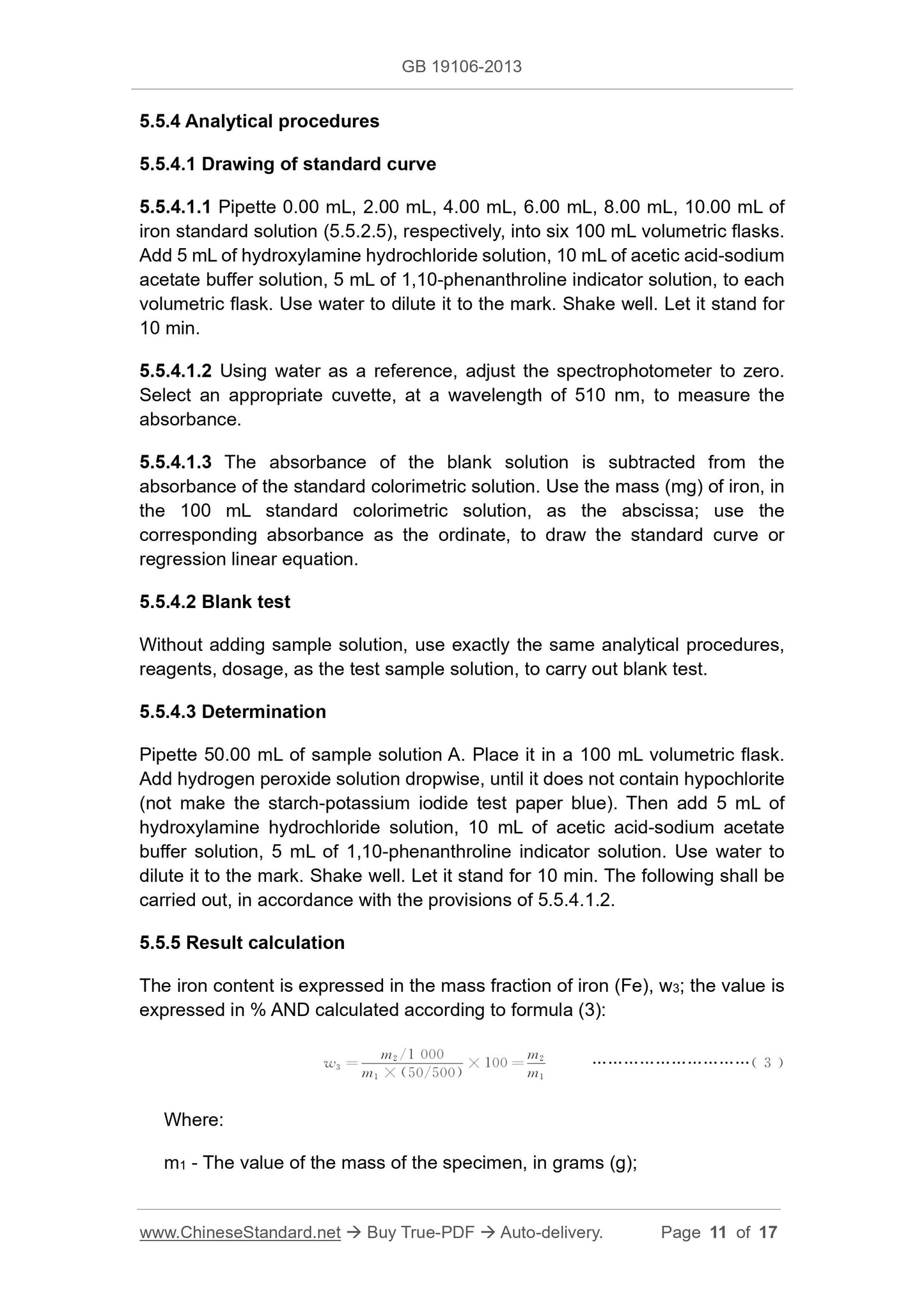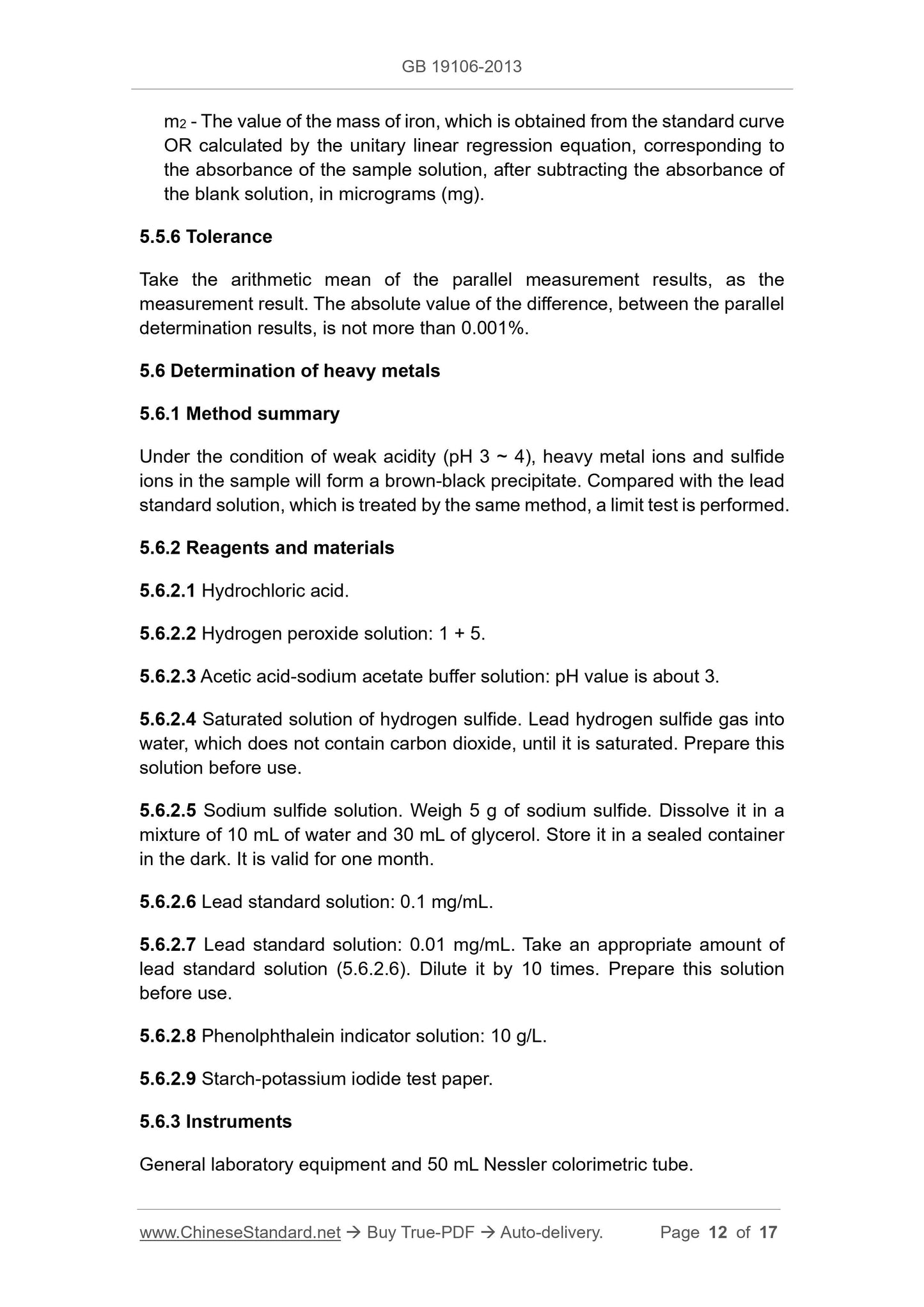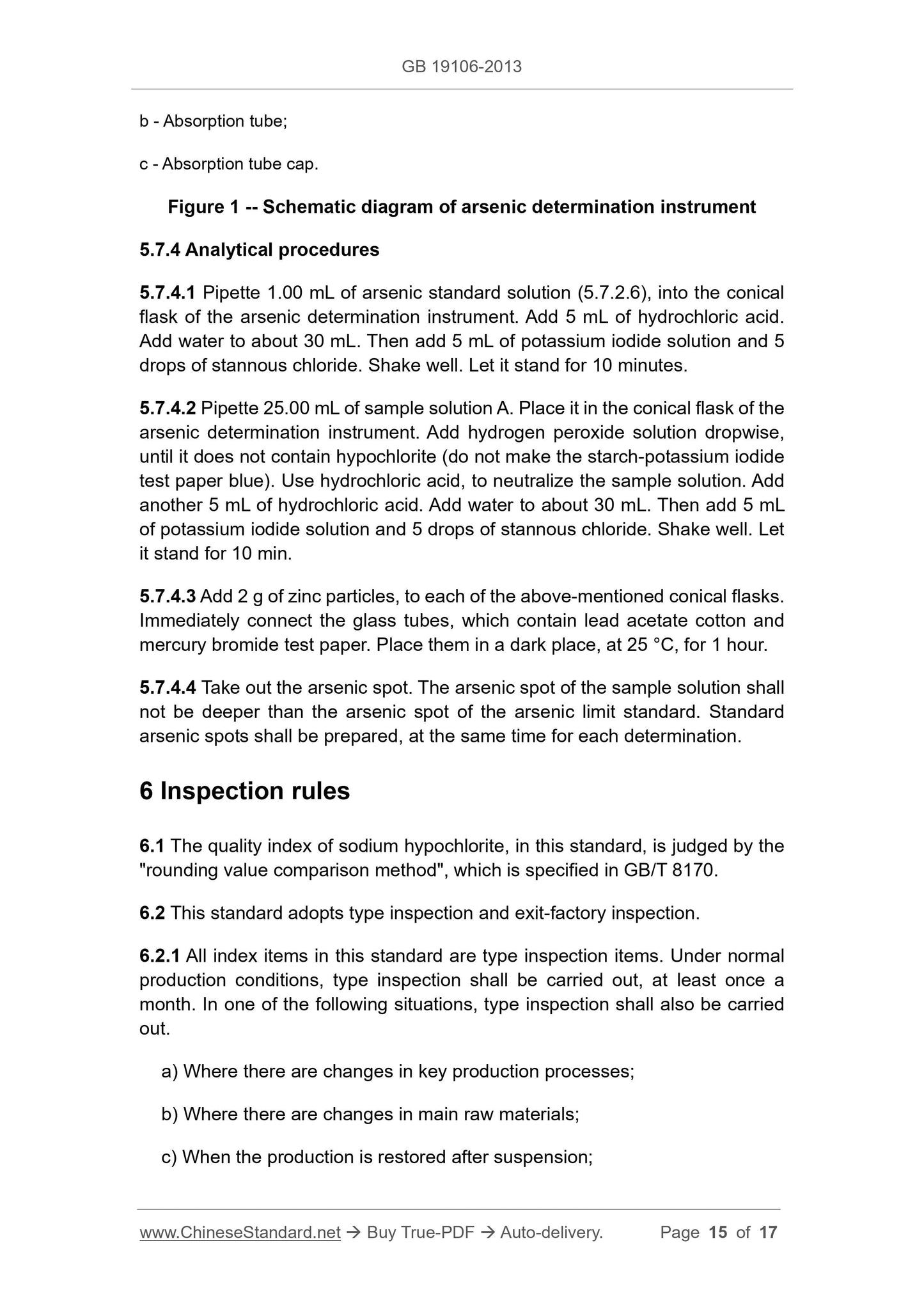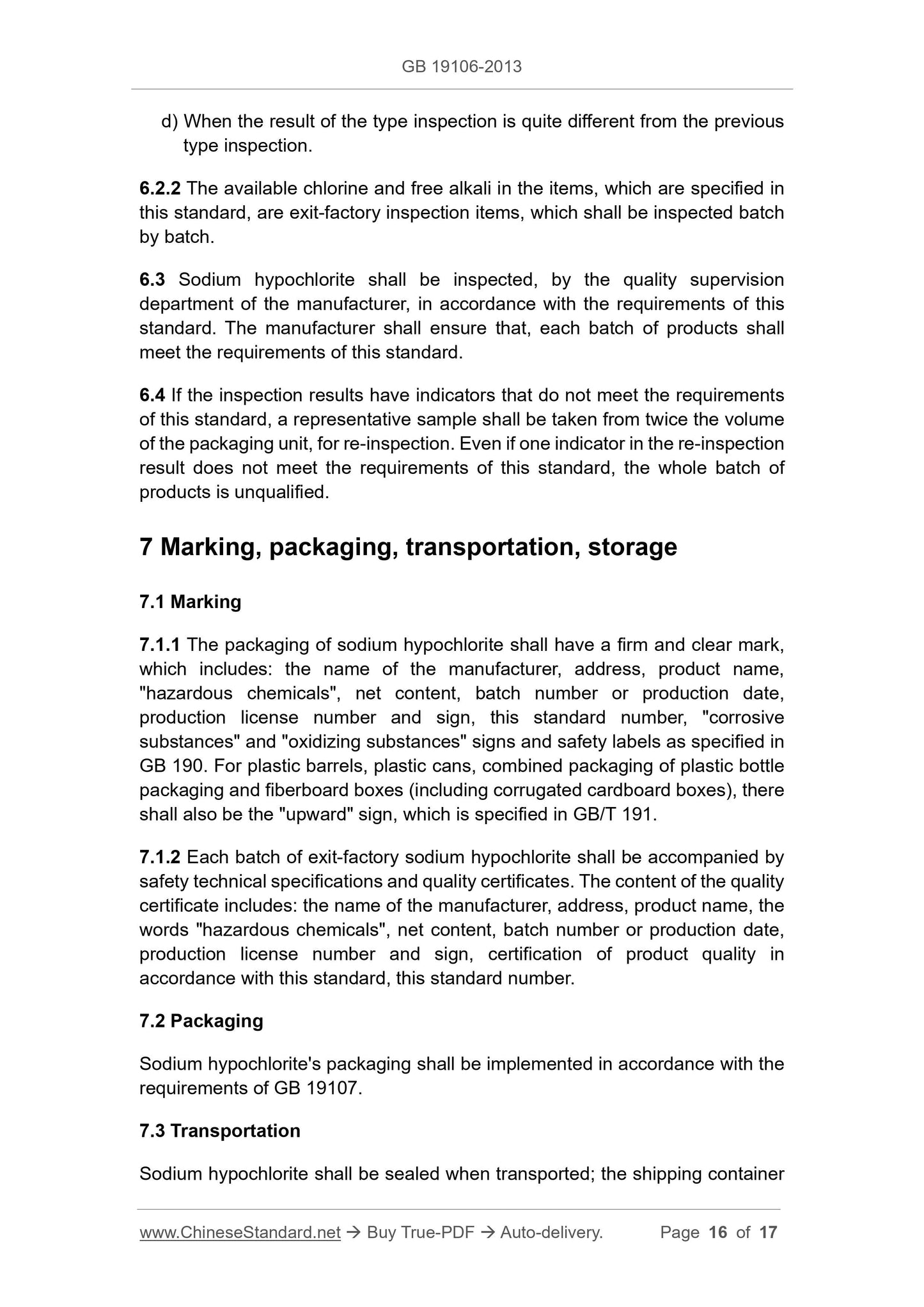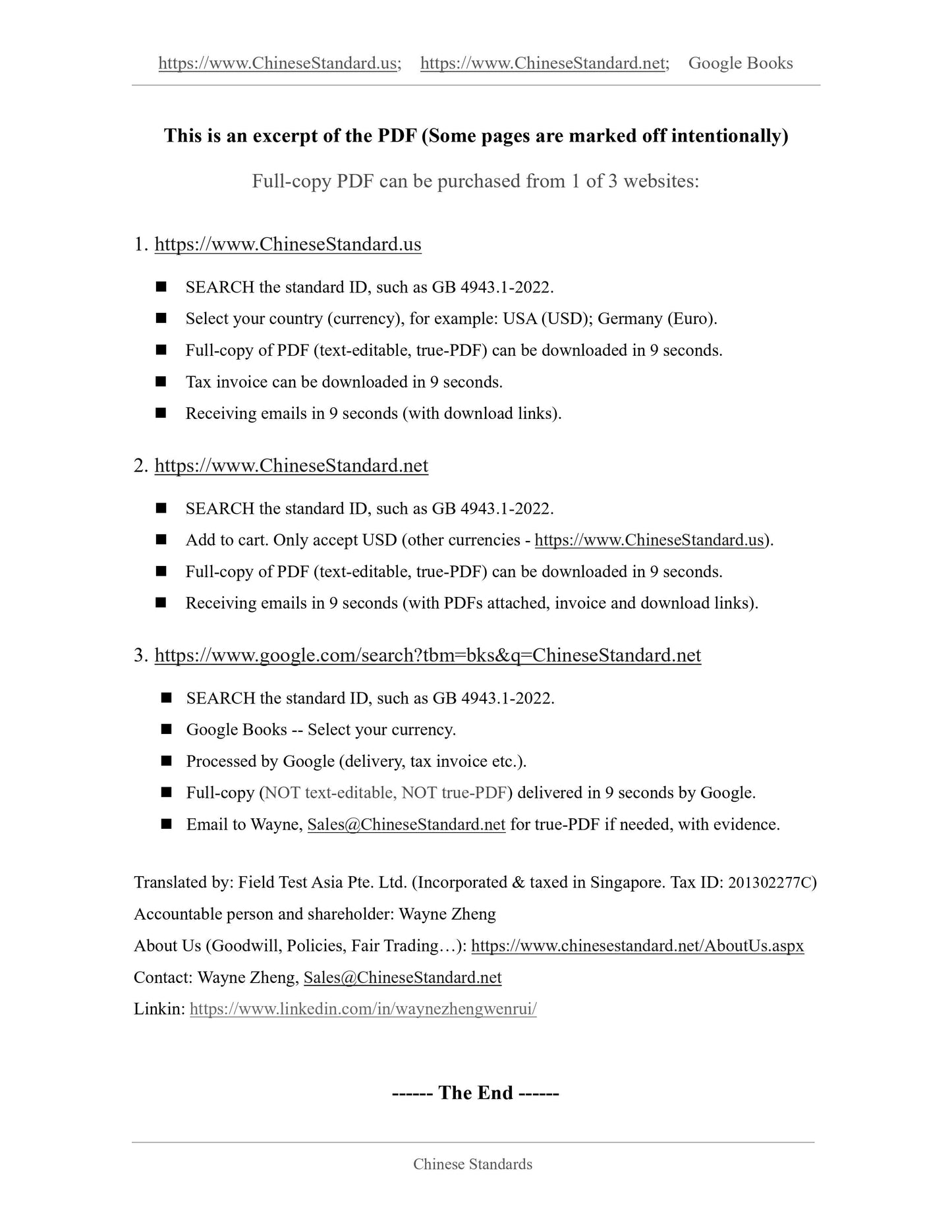1
/
of
9
www.ChineseStandard.us -- Field Test Asia Pte. Ltd.
GB 19106-2013 English PDF
GB 19106-2013 English PDF
Regular price
$185.00
Regular price
Sale price
$185.00
Unit price
/
per
Shipping calculated at checkout.
Couldn't load pickup availability
GB 19106-2013: [GB/T 19106-2013] Sodium hypochlorite
Delivery: 9 seconds. Download (& Email) true-PDF + Invoice.
Get Quotation: Click GB 19106-2013 (Self-service in 1-minute)
Historical versions (Master-website): GB 19106-2013
Preview True-PDF (Reload/Scroll-down if blank)
GB 19106-2013
GB
NATIONAL STANDARD OF THE
PEOPLE’S REPUBLIC OF CHINA
ICS 71.060.50
G 12
Replacing GB 19106-2003
Sodium hypochlorite
次氯酸钠
ISSUED ON: NOVEMBER 27, 2013
IMPLEMENTED ON: DECEMBER 01, 2014
Issued by: General Administration of Quality Supervision, Inspection and
Quarantine of PRC;
Standardization Administration of PRC.
This standard was changed into recommended standard from March 23,
2017. Its number was changed into GB/T 19106-2013.
Table of Contents
Foreword ... 3
1 Scope ... 5
2 Normative references ... 5
3 Requirements ... 6
4 Sampling ... 6
5 Test method ... 7
6 Inspection rules ... 15
7 Marking, packaging, transportation, storage ... 16
Sodium hypochlorite
Warning: Sodium hypochlorite is highly corrosive. Operators shall take
appropriate safety and health measures. Persons exposed to it shall wear
protective glasses, acid and alkali resistant gloves and other protective
equipment.
1 Scope
This standard specifies the requirements, sampling, test methods, inspection
rules and signs, packaging, transportation, storage of sodium hypochlorite.
This standard applies to sodium hypochlorite, which is prepared by chlorination
of sodium hydroxide.
2 Normative references
The following documents are essential to the application of this document. For
the dated documents, only the versions with the dates indicated are applicable
to this document; for the undated documents, only the latest version (including
all the amendments) is applicable to this standard.
GB 190 Packing symbol of dangerous goods
GB/T 191 Pictorial marking for handling of goods (GB/T 191-2009, ISO
780:1997, MOD)
GB/T 601 Chemical reagent - Preparations of standard volumetric solutions
GB/T 602 Chemical reagent – Preparations of standard solutions for impurity
determination (GB/T 602-2002, ISO 6353-1:1982, NEQ)
GB/T 603 Chemical reagent – Preparations of reagent solution for use in test
(GB/T 603-2002, ISO 6353-1:1982, NEQ)
GB/T 6678 General principles for sampling chemical products
GB/T 6680 General rules for sampling liquid chemical products
GB/T 6682 Water for analytical laboratory use - Specification and test
methods (GB/T 6682-2008, ISO 3696:1987, MOD)
GB/T 8170 Rules of rounding off for numerical values and expression and
judgement of limiting values
date, sampling amount, sampling date, name of the sampler.
5 Test method
Safety Tips: Some reagents in this test method are toxic or corrosive, so
it shall be careful when handling them! If splashed on the skin, rinse
immediately with water, AND seek medical treatment immediately, in
severe cases.
5.1 General provisions
The reagents and water, which are used in this standard, refer to analytical
reagents and the grade-3 water, which are specified in GB/T 6682, unless
otherwise specified. The standard titration solution, impurity standard solution,
preparations, products, which are used in the test, are all prepared in
accordance with GB/T 601, GB/T 602, GB/T 603, unless otherwise specified.
5.2 Appearance
Observe visually under natural light.
5.3 Determination of available chlorine
5.3.1 Method summary
In an acidic medium, hypochlorite reacts with potassium iodide, to precipitate
iodine. Using starch as the indicator solution, use sodium thiosulfate standard
titration solution to make titration, until the blue color disappears, which is
regarded as the end point. The reaction formula is as follows:
5.3.2 Reagents
5.3.2.1 Potassium iodide solution: 100 g/L. Weigh 100 g of potassium iodide;
dissolve it in water; dilute to 1000 mL; shake well.
5.3.2.2 Sulfuric acid solution: 3 + 100. Pipette 15 mL of sulfuric acid; slowly
inject 500 mL of water; cool it down; shake well.
5.3.2.3 Sodium thiosulfate standard titration solution: c(Na2S2O3) = 0.1 mol/L.
5.3.2.4 Starch indicator solution: 10 g/L.
5.3.3 Instruments
5.5.4 Analytical procedures
5.5.4.1 Drawing of standard curve
5.5.4.1.1 Pipette 0.00 mL, 2.00 mL, 4.00 mL, 6.00 mL, 8.00 mL, 10.00 mL of
iron standard solution (5.5.2.5), respectively, into six 100 mL volumetric flasks.
Add 5 mL of hydroxylamine hydrochloride solution, 10 mL of acetic acid-sodium
acetate buffer solution, 5 mL of 1,10-phenanthroline indicator solution, to each
volumetric flask. Use water to dilute it to the mark. Shake well. Let it stand for
10 min.
5.5.4.1.2 Using water as a reference, adjust the spectrophotometer to zero.
Select an appropriate cuvette, at a wavelength of 510 nm, to measure the
absorbance.
5.5.4.1.3 The absorbance of the blank solution is subtracted from the
absorbance of the standard colorimetric solution. Use the mass (mg) of iron, in
the 100 mL standard colorimetric solution, as the abscissa; use the
corresponding absorbance as the ordinate, to draw the standard curve or
regression linear equation.
5.5.4.2 Blank test
Without adding sample solution, use exactly the same analytical procedures,
reagents, dosage, as the test sample solution, to carry out blank test.
5.5.4.3 Determination
Pipette 50.00 mL of sample solution A. Place it in a 100 mL volumetric flask.
Add hydrogen peroxide solution dropwise, until it does not contain hypochlorite
(not make the starch-potassium iodide test paper blue). Then add 5 mL of
hydroxylamine hydrochloride solution, 10 mL of acetic acid-sodium acetate
buffer solution, 5 mL of 1,10-phenanthroline indicator solution. Use water to
dilute it to the mark. Shake well. Let it stand for 10 min. The following shall be
carried out, in accordance with the provisions of 5.5.4.1.2.
5.5.5 Result calculation
The iron content is expressed in the mass fraction of iron (Fe), w3; the value is
expressed in % AND calculated according to formula (3):
Where:
m1 - The value of the mass of the specimen, in grams (g);
m2 - The value of the mass of iron, which is obtained from the standard curve
OR calculated by the unitary linear regression equation, corresponding to
the absorbance of the sample solution, after subtracting the absorbance of
the blank solution, in micrograms (mg).
5.5.6 Tolerance
Take the arithmetic mean of the parallel measurement results, as the
measurement result. The absolute value of the difference, between the parallel
determination results, is not more than 0.001%.
5.6 Determination of heavy metals
5.6.1 Method summary
Under the condition of weak acidity (pH 3 ~ 4), heavy metal ions and sulfide
ions in the sample will form a brown-black precipitate. Compared with the lead
standard solution, which is treated by the same method, a limit test is performed.
5.6.2 Reagents and materials
5.6.2.1 Hydrochloric acid.
5.6.2.2 Hydrogen peroxide solution: 1 + 5.
5.6.2.3 Acetic acid-sodium acetate buffer solution: pH value is about 3.
5.6.2.4 Saturated solution of hydrogen sulfide. Lead hydrogen sulfide gas into
water, which does not contain carbon dioxide, until it is saturated. Prepare this
solution before use.
5.6.2.5 Sodium sulfide solution. Weigh 5 g of sodium sulfide. Dissolve it in a
mixture of 10 mL of water and 30 mL of glycerol. Store it in a sealed container
in the dark. It is valid for one month.
5.6.2.6 Lead standard solution: 0.1 mg/mL.
5.6.2.7 Lead standard solution: 0.01 mg/mL. Take an appropriate amount of
lead standard solution (5.6.2.6). Dilute it by 10 times. Prepare this solution
before use.
5.6.2.8 Phenolphthalein indicator solution: 10 g/L.
5.6.2.9 Starch-potassium iodide test paper.
5.6.3 Instruments
General laboratory equipment and 50 mL Nessler colorimetric tube.
b - Absorption tube;
c - Absorption tube cap.
Figure 1 -- Schematic diagram of arsenic determination instrument
5.7.4 Analytical procedures
5.7.4.1 Pipette 1.00 mL of arsenic standard solution (5.7.2.6), into the conical
flask of the arsenic determination instrument. Add 5 mL of hydrochloric acid.
Add water to about 30 mL. Then add 5 mL of potassium iodide solution and 5
drops of stannous chloride. Shake well. Let it stand for 10 minutes.
5.7.4.2 Pipette 25.00 mL of sample solution A. Place it in the conical flask of the
arsenic determination instrument. Add hydrogen peroxide solution dropwise,
until it does not contain hypochlorite (do not make the starch-potassium iodide
test paper blue). Use hydrochloric acid, to neutralize the sample solution. Add
another 5 mL of hydrochloric acid. Add water to about 30 mL. Then add 5 mL
of potassium iodide solution and 5 drops of stannous chloride. Shake well. Let
it stand for 10 min.
5.7.4.3 Add 2 g of zinc particles, to each of the above-mentioned conical flasks.
Immediately connect the glass tubes, which contain lead acetate cotton and
mercury bromide test paper. Place them in a dark place, at 25 °C, for 1 hour.
5.7.4.4 Take out the arsenic spot. The arsenic spot of the sample solution shall
not be deeper than the arsenic spot of the arsenic limit standard. Standard
arsenic spots shall be prepared, at the same time for each determination.
6 Inspection rules
6.1 The quality index of sodium hypochlorite, in this standard, is judged by the
"rounding value comparison method", which is specified in GB/T 8170.
6.2 This standard adopts type inspection and exit-factory inspection.
6.2.1 All index items in this standard are type inspection items. Under normal
production conditions, type inspection shall be carried out, at least once a
month. In one of the following situations, type inspection shall also be carried
out.
a) Where there are changes in key production processes;
b) Where there are changes in main raw materials;
c) When the production is restored after suspension;
d) When the result of the type inspection is quite different from the previous
type inspection.
6.2.2 The available chlorine and free alkali in the items, which are specified in
this standard, are exit-factory inspection items, which shall be inspected batch
by batch.
6.3 Sodium hypochlorite shall be inspected, by the quality supervision
department of the manufacturer, in accordance with the requirements of this
standard. The manufacturer shall ensure that, each batch of products shall
meet the requirements of this standard.
6.4 If the inspection results have indicators that do not meet the requirements
of this standard, a representative sample shall be taken from twice the volume
of the packaging unit, for re-inspection. Even if one indicator in the re-inspection
result does not meet the requirements of this standard, the whole batch of
products is unqualified.
7 Marking, packaging, transportation, storage
7.1 Marking
7.1.1 The packaging of sodium hypochlorite shall have a firm and clear mark,
which includes: the name of the manufacturer, address, product name,
"hazardous chemicals", net content, batch number or production date,
production license number and sign, this standard number, "corrosive
substances" and "oxidizing substances" signs and safety labels as specified in
GB 190. For plastic barrels, plastic cans, combined packaging of plastic bottle
packaging and fiberboard boxes (including corrugated cardboard boxes), there
shall also be the "upward" sign, which is specified in GB/T 191.
7.1.2 Each batch of exit-factory sodium hypochlorite shall be accompanied by
safety technical specifications and quality certificates. The content of the quality
certificate includes: the name of the manufacturer, address, product name, the
words "hazardous chemicals", net content, batch number or production date,
production license number and sign, certification of product quality in
accordance with this standard, this standard number.
7.2 Packaging
Sodium hypochlorite's packaging shall be implemented in accordance with the
requirements of GB 19107.
7.3 Transportation
Sodium hypochlorite shall be sealed when transported; the shipping container
GB 19106-2013
GB
NATIONAL STANDARD OF THE
PEOPLE’S REPUBLIC OF CHINA
ICS 71.060.50
G 12
Replacing GB 19106-2003
Sodium hypochlorite
次氯酸钠
ISSUED ON: NOVEMBER 27, 2013
IMPLEMENTED ON: DECEMBER 01, 2014
Issued by: General Administration of Quality Supervision, Inspection and
Quarantine of PRC;
Standardization Administration of PRC.
This standard was changed into recommended standard from March 23,
2017. Its number was changed into GB/T 19106-2013.
Table of Contents
Foreword ... 3
1 Scope ... 5
2 Normative references ... 5
3 Requirements ... 6
4 Sampling ... 6
5 Test method ... 7
6 Inspection rules ... 15
7 Marking, packaging, transportation, storage ... 16
Sodium hypochlorite
Warning: Sodium hypochlorite is highly corrosive. Operators shall take
appropriate safety and health measures. Persons exposed to it shall wear
protective glasses, acid and alkali resistant gloves and other protective
equipment.
1 Scope
This standard specifies the requirements, sampling, test methods, inspection
rules and signs, packaging, transportation, storage of sodium hypochlorite.
This standard applies to sodium hypochlorite, which is prepared by chlorination
of sodium hydroxide.
2 Normative references
The following documents are essential to the application of this document. For
the dated documents, only the versions with the dates indicated are applicable
to this document; for the undated documents, only the latest version (including
all the amendments) is applicable to this standard.
GB 190 Packing symbol of dangerous goods
GB/T 191 Pictorial marking for handling of goods (GB/T 191-2009, ISO
780:1997, MOD)
GB/T 601 Chemical reagent - Preparations of standard volumetric solutions
GB/T 602 Chemical reagent – Preparations of standard solutions for impurity
determination (GB/T 602-2002, ISO 6353-1:1982, NEQ)
GB/T 603 Chemical reagent – Preparations of reagent solution for use in test
(GB/T 603-2002, ISO 6353-1:1982, NEQ)
GB/T 6678 General principles for sampling chemical products
GB/T 6680 General rules for sampling liquid chemical products
GB/T 6...
Delivery: 9 seconds. Download (& Email) true-PDF + Invoice.
Get Quotation: Click GB 19106-2013 (Self-service in 1-minute)
Historical versions (Master-website): GB 19106-2013
Preview True-PDF (Reload/Scroll-down if blank)
GB 19106-2013
GB
NATIONAL STANDARD OF THE
PEOPLE’S REPUBLIC OF CHINA
ICS 71.060.50
G 12
Replacing GB 19106-2003
Sodium hypochlorite
次氯酸钠
ISSUED ON: NOVEMBER 27, 2013
IMPLEMENTED ON: DECEMBER 01, 2014
Issued by: General Administration of Quality Supervision, Inspection and
Quarantine of PRC;
Standardization Administration of PRC.
This standard was changed into recommended standard from March 23,
2017. Its number was changed into GB/T 19106-2013.
Table of Contents
Foreword ... 3
1 Scope ... 5
2 Normative references ... 5
3 Requirements ... 6
4 Sampling ... 6
5 Test method ... 7
6 Inspection rules ... 15
7 Marking, packaging, transportation, storage ... 16
Sodium hypochlorite
Warning: Sodium hypochlorite is highly corrosive. Operators shall take
appropriate safety and health measures. Persons exposed to it shall wear
protective glasses, acid and alkali resistant gloves and other protective
equipment.
1 Scope
This standard specifies the requirements, sampling, test methods, inspection
rules and signs, packaging, transportation, storage of sodium hypochlorite.
This standard applies to sodium hypochlorite, which is prepared by chlorination
of sodium hydroxide.
2 Normative references
The following documents are essential to the application of this document. For
the dated documents, only the versions with the dates indicated are applicable
to this document; for the undated documents, only the latest version (including
all the amendments) is applicable to this standard.
GB 190 Packing symbol of dangerous goods
GB/T 191 Pictorial marking for handling of goods (GB/T 191-2009, ISO
780:1997, MOD)
GB/T 601 Chemical reagent - Preparations of standard volumetric solutions
GB/T 602 Chemical reagent – Preparations of standard solutions for impurity
determination (GB/T 602-2002, ISO 6353-1:1982, NEQ)
GB/T 603 Chemical reagent – Preparations of reagent solution for use in test
(GB/T 603-2002, ISO 6353-1:1982, NEQ)
GB/T 6678 General principles for sampling chemical products
GB/T 6680 General rules for sampling liquid chemical products
GB/T 6682 Water for analytical laboratory use - Specification and test
methods (GB/T 6682-2008, ISO 3696:1987, MOD)
GB/T 8170 Rules of rounding off for numerical values and expression and
judgement of limiting values
date, sampling amount, sampling date, name of the sampler.
5 Test method
Safety Tips: Some reagents in this test method are toxic or corrosive, so
it shall be careful when handling them! If splashed on the skin, rinse
immediately with water, AND seek medical treatment immediately, in
severe cases.
5.1 General provisions
The reagents and water, which are used in this standard, refer to analytical
reagents and the grade-3 water, which are specified in GB/T 6682, unless
otherwise specified. The standard titration solution, impurity standard solution,
preparations, products, which are used in the test, are all prepared in
accordance with GB/T 601, GB/T 602, GB/T 603, unless otherwise specified.
5.2 Appearance
Observe visually under natural light.
5.3 Determination of available chlorine
5.3.1 Method summary
In an acidic medium, hypochlorite reacts with potassium iodide, to precipitate
iodine. Using starch as the indicator solution, use sodium thiosulfate standard
titration solution to make titration, until the blue color disappears, which is
regarded as the end point. The reaction formula is as follows:
5.3.2 Reagents
5.3.2.1 Potassium iodide solution: 100 g/L. Weigh 100 g of potassium iodide;
dissolve it in water; dilute to 1000 mL; shake well.
5.3.2.2 Sulfuric acid solution: 3 + 100. Pipette 15 mL of sulfuric acid; slowly
inject 500 mL of water; cool it down; shake well.
5.3.2.3 Sodium thiosulfate standard titration solution: c(Na2S2O3) = 0.1 mol/L.
5.3.2.4 Starch indicator solution: 10 g/L.
5.3.3 Instruments
5.5.4 Analytical procedures
5.5.4.1 Drawing of standard curve
5.5.4.1.1 Pipette 0.00 mL, 2.00 mL, 4.00 mL, 6.00 mL, 8.00 mL, 10.00 mL of
iron standard solution (5.5.2.5), respectively, into six 100 mL volumetric flasks.
Add 5 mL of hydroxylamine hydrochloride solution, 10 mL of acetic acid-sodium
acetate buffer solution, 5 mL of 1,10-phenanthroline indicator solution, to each
volumetric flask. Use water to dilute it to the mark. Shake well. Let it stand for
10 min.
5.5.4.1.2 Using water as a reference, adjust the spectrophotometer to zero.
Select an appropriate cuvette, at a wavelength of 510 nm, to measure the
absorbance.
5.5.4.1.3 The absorbance of the blank solution is subtracted from the
absorbance of the standard colorimetric solution. Use the mass (mg) of iron, in
the 100 mL standard colorimetric solution, as the abscissa; use the
corresponding absorbance as the ordinate, to draw the standard curve or
regression linear equation.
5.5.4.2 Blank test
Without adding sample solution, use exactly the same analytical procedures,
reagents, dosage, as the test sample solution, to carry out blank test.
5.5.4.3 Determination
Pipette 50.00 mL of sample solution A. Place it in a 100 mL volumetric flask.
Add hydrogen peroxide solution dropwise, until it does not contain hypochlorite
(not make the starch-potassium iodide test paper blue). Then add 5 mL of
hydroxylamine hydrochloride solution, 10 mL of acetic acid-sodium acetate
buffer solution, 5 mL of 1,10-phenanthroline indicator solution. Use water to
dilute it to the mark. Shake well. Let it stand for 10 min. The following shall be
carried out, in accordance with the provisions of 5.5.4.1.2.
5.5.5 Result calculation
The iron content is expressed in the mass fraction of iron (Fe), w3; the value is
expressed in % AND calculated according to formula (3):
Where:
m1 - The value of the mass of the specimen, in grams (g);
m2 - The value of the mass of iron, which is obtained from the standard curve
OR calculated by the unitary linear regression equation, corresponding to
the absorbance of the sample solution, after subtracting the absorbance of
the blank solution, in micrograms (mg).
5.5.6 Tolerance
Take the arithmetic mean of the parallel measurement results, as the
measurement result. The absolute value of the difference, between the parallel
determination results, is not more than 0.001%.
5.6 Determination of heavy metals
5.6.1 Method summary
Under the condition of weak acidity (pH 3 ~ 4), heavy metal ions and sulfide
ions in the sample will form a brown-black precipitate. Compared with the lead
standard solution, which is treated by the same method, a limit test is performed.
5.6.2 Reagents and materials
5.6.2.1 Hydrochloric acid.
5.6.2.2 Hydrogen peroxide solution: 1 + 5.
5.6.2.3 Acetic acid-sodium acetate buffer solution: pH value is about 3.
5.6.2.4 Saturated solution of hydrogen sulfide. Lead hydrogen sulfide gas into
water, which does not contain carbon dioxide, until it is saturated. Prepare this
solution before use.
5.6.2.5 Sodium sulfide solution. Weigh 5 g of sodium sulfide. Dissolve it in a
mixture of 10 mL of water and 30 mL of glycerol. Store it in a sealed container
in the dark. It is valid for one month.
5.6.2.6 Lead standard solution: 0.1 mg/mL.
5.6.2.7 Lead standard solution: 0.01 mg/mL. Take an appropriate amount of
lead standard solution (5.6.2.6). Dilute it by 10 times. Prepare this solution
before use.
5.6.2.8 Phenolphthalein indicator solution: 10 g/L.
5.6.2.9 Starch-potassium iodide test paper.
5.6.3 Instruments
General laboratory equipment and 50 mL Nessler colorimetric tube.
b - Absorption tube;
c - Absorption tube cap.
Figure 1 -- Schematic diagram of arsenic determination instrument
5.7.4 Analytical procedures
5.7.4.1 Pipette 1.00 mL of arsenic standard solution (5.7.2.6), into the conical
flask of the arsenic determination instrument. Add 5 mL of hydrochloric acid.
Add water to about 30 mL. Then add 5 mL of potassium iodide solution and 5
drops of stannous chloride. Shake well. Let it stand for 10 minutes.
5.7.4.2 Pipette 25.00 mL of sample solution A. Place it in the conical flask of the
arsenic determination instrument. Add hydrogen peroxide solution dropwise,
until it does not contain hypochlorite (do not make the starch-potassium iodide
test paper blue). Use hydrochloric acid, to neutralize the sample solution. Add
another 5 mL of hydrochloric acid. Add water to about 30 mL. Then add 5 mL
of potassium iodide solution and 5 drops of stannous chloride. Shake well. Let
it stand for 10 min.
5.7.4.3 Add 2 g of zinc particles, to each of the above-mentioned conical flasks.
Immediately connect the glass tubes, which contain lead acetate cotton and
mercury bromide test paper. Place them in a dark place, at 25 °C, for 1 hour.
5.7.4.4 Take out the arsenic spot. The arsenic spot of the sample solution shall
not be deeper than the arsenic spot of the arsenic limit standard. Standard
arsenic spots shall be prepared, at the same time for each determination.
6 Inspection rules
6.1 The quality index of sodium hypochlorite, in this standard, is judged by the
"rounding value comparison method", which is specified in GB/T 8170.
6.2 This standard adopts type inspection and exit-factory inspection.
6.2.1 All index items in this standard are type inspection items. Under normal
production conditions, type inspection shall be carried out, at least once a
month. In one of the following situations, type inspection shall also be carried
out.
a) Where there are changes in key production processes;
b) Where there are changes in main raw materials;
c) When the production is restored after suspension;
d) When the result of the type inspection is quite different from the previous
type inspection.
6.2.2 The available chlorine and free alkali in the items, which are specified in
this standard, are exit-factory inspection items, which shall be inspected batch
by batch.
6.3 Sodium hypochlorite shall be inspected, by the quality supervision
department of the manufacturer, in accordance with the requirements of this
standard. The manufacturer shall ensure that, each batch of products shall
meet the requirements of this standard.
6.4 If the inspection results have indicators that do not meet the requirements
of this standard, a representative sample shall be taken from twice the volume
of the packaging unit, for re-inspection. Even if one indicator in the re-inspection
result does not meet the requirements of this standard, the whole batch of
products is unqualified.
7 Marking, packaging, transportation, storage
7.1 Marking
7.1.1 The packaging of sodium hypochlorite shall have a firm and clear mark,
which includes: the name of the manufacturer, address, product name,
"hazardous chemicals", net content, batch number or production date,
production license number and sign, this standard number, "corrosive
substances" and "oxidizing substances" signs and safety labels as specified in
GB 190. For plastic barrels, plastic cans, combined packaging of plastic bottle
packaging and fiberboard boxes (including corrugated cardboard boxes), there
shall also be the "upward" sign, which is specified in GB/T 191.
7.1.2 Each batch of exit-factory sodium hypochlorite shall be accompanied by
safety technical specifications and quality certificates. The content of the quality
certificate includes: the name of the manufacturer, address, product name, the
words "hazardous chemicals", net content, batch number or production date,
production license number and sign, certification of product quality in
accordance with this standard, this standard number.
7.2 Packaging
Sodium hypochlorite's packaging shall be implemented in accordance with the
requirements of GB 19107.
7.3 Transportation
Sodium hypochlorite shall be sealed when transported; the shipping container
GB 19106-2013
GB
NATIONAL STANDARD OF THE
PEOPLE’S REPUBLIC OF CHINA
ICS 71.060.50
G 12
Replacing GB 19106-2003
Sodium hypochlorite
次氯酸钠
ISSUED ON: NOVEMBER 27, 2013
IMPLEMENTED ON: DECEMBER 01, 2014
Issued by: General Administration of Quality Supervision, Inspection and
Quarantine of PRC;
Standardization Administration of PRC.
This standard was changed into recommended standard from March 23,
2017. Its number was changed into GB/T 19106-2013.
Table of Contents
Foreword ... 3
1 Scope ... 5
2 Normative references ... 5
3 Requirements ... 6
4 Sampling ... 6
5 Test method ... 7
6 Inspection rules ... 15
7 Marking, packaging, transportation, storage ... 16
Sodium hypochlorite
Warning: Sodium hypochlorite is highly corrosive. Operators shall take
appropriate safety and health measures. Persons exposed to it shall wear
protective glasses, acid and alkali resistant gloves and other protective
equipment.
1 Scope
This standard specifies the requirements, sampling, test methods, inspection
rules and signs, packaging, transportation, storage of sodium hypochlorite.
This standard applies to sodium hypochlorite, which is prepared by chlorination
of sodium hydroxide.
2 Normative references
The following documents are essential to the application of this document. For
the dated documents, only the versions with the dates indicated are applicable
to this document; for the undated documents, only the latest version (including
all the amendments) is applicable to this standard.
GB 190 Packing symbol of dangerous goods
GB/T 191 Pictorial marking for handling of goods (GB/T 191-2009, ISO
780:1997, MOD)
GB/T 601 Chemical reagent - Preparations of standard volumetric solutions
GB/T 602 Chemical reagent – Preparations of standard solutions for impurity
determination (GB/T 602-2002, ISO 6353-1:1982, NEQ)
GB/T 603 Chemical reagent – Preparations of reagent solution for use in test
(GB/T 603-2002, ISO 6353-1:1982, NEQ)
GB/T 6678 General principles for sampling chemical products
GB/T 6680 General rules for sampling liquid chemical products
GB/T 6...
Share
